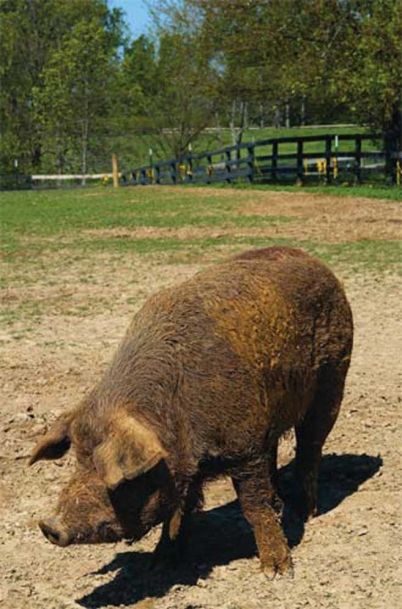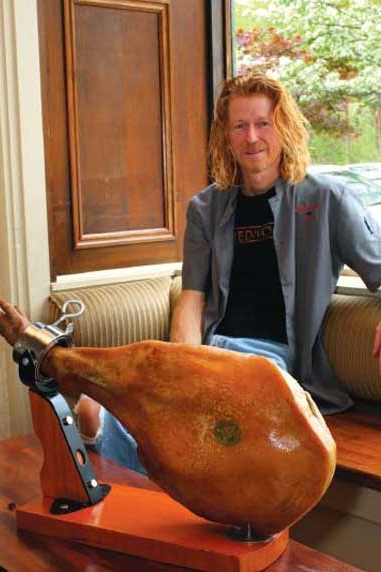From Dog to Hog
You’re not supposed to name animals destined for the dinner plate.
But Virgil, Bob Hancock’s massive Red Wattle boar, isn’t going anywhere. He has an esteemed position among Hancock’s herd of 17 pigs on an Oldham County farm, where he lives with Delilah, a Red Wattle cross who guaranteed her permanent position as a breeding sow by being the smartest hog of the bunch.
By day, Bob Hancock, and his wife, Kit Garrett, own and operate the Blue Dog Bakery and Café, which opened 14 years ago in Crescent Hill and turns out what Food & Wine magazine called “as good as any bread you will find in the U.S and competitive with the best in Europe.”
Hancock doesn’t do things by half measures; the term “obsessive” has been uttered in his presence by those who know and love him. The 3-year-old pig project started with four ¼-cross Red Wattle meat hogs on a farm in Oldham County. The Red Wattle is a Texas breed known as a ham and bacon pig. The couple also owns a Mulefoot boar — a “critically rare” breed, according to the American Livestock Breeds Conservancy, known for its non-cloven hoof. “The big impetus was to have really good pig we could use” in the restaurant, he says.
After getting two litters on the original farm — a situation he bartered 50% of production for — Hancock moved the pigs to Field Day Farm in Jefferson County, where organic vegetables are raised. Lawyers for that property, which occupies part of Oxmoor Farm south of I-64, worried about liability and, while not putting Hancock in a bind with time limits or ultimatums, asked him to move the pigs. In December he reached an agreement with a farm owner just north of Skylight. The new owner is not a farmer, but is enthusiastic about having the land put to work. The owner repaired broken lines to make water easily available to the paddocks and Hancock will use the former foaling barn as a farrowing shed. Baby pigs can be kept safely in the extra large stalls and sows will have access to the outdoors when they need a break from little ones.
Hancock’s part of the bargain is to keep the 20 acres he uses in good working order while he raises his livestock. Pigs are rooters, and can tear up a two-acre paddock in very little time. They need to be moved often. Pigs are also escape artists, and Hancock has had to reinforce all the horse fences with wire and electric fencing.
In that time, Virgil, Delilah and some of the other sows have created a dirt expanse where horses once grazed. But Hancock is looking forward to replanting it with crops conducive to a healthy pig diet, mixing grass seed with field peas, barley, rye and clover, and maybe a few pumpkins. In Spain, where Hancock spent several weeks in ham country to learn the business, pigs are raised on food grown by the farmer, then released into forests to forage for food.
All the moving from farm to farm, the current improvements and cost of rearing the animals, and of having them processed, has made the enterprise “an expensive hobby,” says Hancock. Stability will help mitigate costs, and increasing the size of the herd allows him to sell to consumers who want to buy by the whole or half. He and Garrett need only three or four hogs for the restaurant.
Why pigs?
“They have personalities,” he says. “It’s probably the most versatile animal to work with in the kitchen. Mainly, they are smart. They are very smart animals to work with. And every single part of the pig can be used, and should be, though that’s a tough sell in this country.”
Any pork at all was a tough sell for Garrett, who used to avoid eating it. “I thought it would make me fat,” she says, “you know — food phobia. I didn’t think it was healthy.” But she became the guinea pig for Hancock’s experiments with coppa di testa (a cold cut seasoned with onion, black pepper, allspice, bay leaf), chorizo, soppressata and everything else Hancock taught himself through “trial and error and practice and reading.”
When Garrett went for her first postpork physical, she warned her husband that if it was bad, she was off pork for the duration. No worries. “My cholesterol was the lowest my doctor had ever seen on anybody,” she says.
In the restaurant, the pork shows up as chops and bacon, of course. But Hancock operates on his conviction that every part ought to be used. Hog cheek meat and tongue goes into tacos. Crispy pig ears top salad. Pork sliders include heart and liver. And fresh pork sausage, tomato and chickpea soup served with poached egg on top starts with a broth made from pork bones and trimmings. Hancock is also making hams — and serving them — the way he saw them in Spain. Ham slices are not cooked in a skillet like they are in Kentucky.
They are served “raw,” and cut so thin that you can nearly read a newspaper through the slices. “The ham is not as revered in this country as it is in Europe,” says Hancock. “In Spain, you don’t hire a band for your wedding, you hire a ham carver.” Though he took a class in Spain to learn how to carve ham, he says, to serve it on tartine or with poached egg in a busy restaurant he relies on a meat slicer. The oldest of Hancock’s hams was two years old. At first Hancock was finicky about how his hams looked. He’d wash and scrape any foreign substance off of them. In Spain he saw hams covered with stuff growing all over them. “Some steely gray, some green, some blue green, some black,” he says.
There’s a curing closet at Blue Dog where one of his hams still hangs. He cut into the other of the pair a few months ago. “It was fantastic,” says Hancock, but he wants something “that was gamier and funkier.”
A natural outcome for their hog operation, says Hancock, is to become a farrowing operation, holding and breeding sows and selling young pigs to farmers who will finish them out for buyers. That setup would allow him to raise enough meat for the restaurant in a way that would support the farm.
All conversations about pig farming eventually get around to those who, unlike Virgil and Delilah, end up on a dinner plate. Hancock, who drives to the farm twice a day to care for the animals, reasons that “the only bad day they have is the last day they’re here,” he says. “I love them when they’re alive and I enjoy the hell out of them when they’re not
Blue Dog Bakery and Café
Blue Dog is located at 2868 Frankfort Ave., just west of Stilz Avenue, in Crescent Hill. Reach them at 502-899-9800; bluedogbakeryandcafe.com. For many months, the space became Red Hog Tapas restaurant on Thursday through Saturday nights, where Hancock and Garrett served a selection of tapas, including varied charcuterie and pizzas made with home-grown pork.
Red Hog Tapas is currently on hiatus, but many of the dishes are offered Tuesday through Saturday for brunch (9am–noon) and lunch (10:30am–2pm) at Blue Dog.







